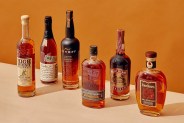In the late 1980s, Booker Noe, grandson of Jim Beam, was royally pissed off. American whiskey makers had been beaten to a pulp by vodka, rum and tequila producers for two decades, and had been forced to cut down their whiskey’s strength as a result. But Booker Noe didn’t like light whiskey — his everyday drinker was 100-proof, Bottled-in-Bond Old Tub. So Noe decided he’d make something just for himself and his family — a juiced-up, full-flavored, uncut, unfiltered bourbon. Regularly anywhere between 125 and 130 proof, Booker’s Bourbon was born, and with it, the beginning of a decades-long ABV spike.
At the time, Booker’s Bourbon was a premium, novelty bourbon priced at a then unheard of $40 a bottle. Today, riding the back of an enormous base of new whiskey enthusiasts seeking higher and higher-ABV whiskey, there is competition in the high proof market. A lot of it. And it’s led newer devotees to ask themselves a simple sounding question: is high proof whiskey better?
Co-founder of New Riff Distilling, Jay Erisman believes high proof whiskey is better whiskey, but not because of the alcohol content.
“Whiskey has flavor, and water, distinctly, does not. The more water a distiller adds to the bottled product to achieve a lower proof — but higher profits — the less flavor will result in the product. Simple as that,” Erisman explains.
New Riff is a rarity in the whiskey world: a Kentucky-based craft distiller that only sells whiskey it distills and ages itself. Plus, all its whiskey offerings are proofed at 100 or more. But not everyone is so sure about a linear relationship between proof and quality.
Master Blender at Suntory and the man behind some of the most coveted Japanese whiskies on the market, Shinji Fukuyo believes proofs exceeding 100, 110 and certainly 120 blur the subtleties of a finer spirit.
Ardbeg’s head of maturing whisky stocks Brendan McCarron thinks Americans might go a bit too far with proofing (scotch whisky rarely reaches the proof levels many American distilleries do nowadays), but he acknowledges it’s not for nothing. “I think part of it is a kind of ‘I can do more than you can do.’ You know, if you like 120 proof, well I must like 130 then, because that’s bigger. But it also gives the consumer more ways to drink the spirits, too.”

